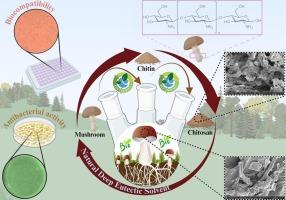可持续生物聚合物设计:利用天然深层共晶溶剂提取甲壳素和壳聚糖,具有更好的抗菌功能
IF 7.9
2区 材料科学
Q1 MATERIALS SCIENCE, MULTIDISCIPLINARY
引用次数: 0
摘要
利用天然深共晶溶剂(NADES)提取生物聚合物为开发生物医学应用的可持续和生物相容性材料提供了一种很有前途的方法。本研究开发了一种从有机双孢蘑菇中提取甲壳素和壳聚糖的新工艺,这是一种易于获取的可再生资源。NADES不仅提高了提取效率,而且保持了生物聚合物的结构完整性。采用x射线衍射(XRD)、傅里叶变换红外光谱(FT-IR)、热重(DTG/TGA)、扫描电镜(SEM)、原子力显微镜(AFM)和核磁共振(1H NMR)等技术分析了这些生物聚合物的特征。通过优化NADES提取条件,获得了高纯度的甲壳素(98.58%)和壳聚糖(98.69%),超过了传统化学方法的纯度水平。nades提取的壳聚糖脱乙酰度(DD)高达94.22%,结晶度指数(CrI)高达61.77%,显示出其在生物医学应用方面的增强功能。此外,nades衍生的生物聚合物与L929成纤维细胞具有良好的生物相容性。它们对金黄色葡萄球菌(S. aureus)和大肠杆菌(E. coli)表现出剂量依赖性的抗菌活性,并表现出良好的抗氧化和生物降解性。本文章由计算机程序翻译,如有差异,请以英文原文为准。

Sustainable biopolymer design: extraction of chitin and chitosan using natural deep eutectic solvents with improved antibacterial features
The extraction of biopolymers using natural deep eutectic solvents (NADES) offers a promising approach for developing sustainable and biocompatible materials for biomedical applications. In this study, a novel and environmentally friendly process has been developed for extracting chitin and chitosan from organic Agaricus bisporus (A. bisporus) mushrooms, which serves as a readily available and renewable resource. NADES not only enhances the extraction efficiency but also preserves the structural integrity of the biopolymers. The characteristics of these biopolymers were analyzed by X-ray diffraction (XRD), Fourier transform infrared spectroscopy (FT-IR), thermogravimetric (DTG/TGA) analysis, scanning electron microscopy (SEM), atomic force microscopy (AFM), and nuclear magnetic resonance (1H NMR) techniques. By optimizing the NADES extraction conditions, high-purity chitin (98.58 %) and chitosan (98.69 %) were achieved, surpassing the purity levels achieved by traditional chemical methods. NADES-extracted chitosan exhibited a remarkable degree of deacetylation (DD) of up to 94.22 %, and a crystallinity index (CrI) of up to 61.77 %, highlighting its enhanced functionality for biomedical applications. Moreover, the NADES-derived biopolymers showed excellent biocompatibility with L929 fibroblast cells. They exhibited dose-dependent antibacterial activity against Staphylococcus aureus (S. aureus) and Escherichia coli (E. coli) and exhibited promising antioxidant and biodegradability properties.
求助全文
通过发布文献求助,成功后即可免费获取论文全文。
去求助
来源期刊

Materials & Design
Engineering-Mechanical Engineering
CiteScore
14.30
自引率
7.10%
发文量
1028
审稿时长
85 days
期刊介绍:
Materials and Design is a multi-disciplinary journal that publishes original research reports, review articles, and express communications. The journal focuses on studying the structure and properties of inorganic and organic materials, advancements in synthesis, processing, characterization, and testing, the design of materials and engineering systems, and their applications in technology. It aims to bring together various aspects of materials science, engineering, physics, and chemistry.
The journal explores themes ranging from materials to design and aims to reveal the connections between natural and artificial materials, as well as experiment and modeling. Manuscripts submitted to Materials and Design should contain elements of discovery and surprise, as they often contribute new insights into the architecture and function of matter.
 求助内容:
求助内容: 应助结果提醒方式:
应助结果提醒方式:


